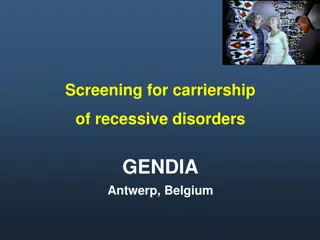Exploring the Pros and Cons of Genetic Engineering
Delve into the world of genetic modification, uncovering its advantages such as potential breakthroughs in treating inherited disorders and improved crop quality. However, concerns include unknown long-term health impacts, environmental risks, and ethical dilemmas. Engage with various viewpoints through discussions about genetic engineering's impact on society and the environment.
Download Presentation

Please find below an Image/Link to download the presentation.
The content on the website is provided AS IS for your information and personal use only. It may not be sold, licensed, or shared on other websites without obtaining consent from the author.If you encounter any issues during the download, it is possible that the publisher has removed the file from their server.
You are allowed to download the files provided on this website for personal or commercial use, subject to the condition that they are used lawfully. All files are the property of their respective owners.
The content on the website is provided AS IS for your information and personal use only. It may not be sold, licensed, or shared on other websites without obtaining consent from the author.
E N D
Presentation Transcript
Ethics of gene technologies Progress indicators Good progress: Discuss the process of genetic modification and it s advantages Make informed judgements about the economic, social and ethical issues concerning genetic engineering and GM crops. Outstanding progress: Explain advantages and disadvantages of genetic engineering. Do now activity: 1. What is genetic modification? 2. Describe how bacteria can be genetically engineered to produce human insulin 3. Why might certain groups of people be concerned with how quickly gene technologies have been developed and used?
THINK > PAIR > SHARE: What do you think are some of the advantages and disadvantages of gene technologies are?
Task: Watch the following videos and try and note down some of the advantages and disadvantages of gene technologies https://www.youtube.com/watch?v=rx953M-tpp4 https://www.youtube.com/watch?v=1H9WZGKQeYg https://www.youtube.com/watch?v=HSten18rI9A Advantages Disadvantages
Task: In groups, read through the cards of information on the benefits and concerns of genetic modification. Sort them into two groups and use these to complete your table.
Advantages Disadvantages Scientists are researching ways to insert healthy genes into affected cells to try and make them work more effectively. This could be a breakthrough for those families suffering with inherited disorders. Some people are very concerned about the impact of eating genetically modified food on human health. We haven t been able to monitor the long-term impact of this yet. Genes from GM plants and animals may spread to wildlife which could have devastating effects on wild flowers and insects. This in turn has a knock on effect to organisms higher up the food chain. Genetic engineering in agriculture can lead to an increased food value of crops. Crops can be designed to have certain features which gives them a selective advantage. E.g. grown in certain temperatures, contain pesticides, resistant to herbicides. There are ethical concerns surrounding the genetic modification of humans. This technology could lead to people demanding designer babies in the future.
Task: Complete a news article on the concerns and benefits of genetic engineering for the Daily Science page in your local newspaper. Make sure you include opinions from the following people: An organic farmer A campaigner from the charity Stop World Hunger A local ecologist A doctor A scientist working on a new gene technology
Exam-style question 7 marks = 7 minutes Insects can be both useful and harmful to crop plants. Insects such as bees pollinate the flowers of some crop plants. Pollination is needed for successful sexual reproduction of crop plants. Some insects eat crops and other insects eat the insects that eat crops. a) Describe how scientists can transfer the gene from Bacillus thuringiensis to maize plants. (3) Corn borers are insects that eat maize plants. A toxin produced by the bacterium Bacillus thuringiensis kills insects. Scientists grow Bacillus thuringiensis in large containers. The toxin is collected from the containers and is sprayed over maize crops to kill corn borers. b) Would you advise farmers to grow GM maize plants? Justify your answer by giving advantages and disadvantages of growing GM maize plants. Use the information from the box and your own knowledge to help you. A company has developed genetically modified (GM) maize plants. GM maize plants contain a gene from Bacillus thuringiensis. This gene changes the GM maize plants so that they produce the toxin. (4)
Mark your work: a) Any three from: Gene cut out Gene cut out from chromosome/DNA Reference to enzymes used to cut out gene (restriction enzyme) Gene spliced into maize chromosome/DNA Gene added at early stage of development b) Any four (two advantages & two disadvantages) from: Advantages: Less effort for farmer/less likely to harm farmer Pesticide is always present Less insects to eat the crops or carry disease Greater crop production/greater yield Disadvantages: Toxins kill other insects Crops don t get pollinated Possible harm when eaten by humans/animals Damage to food chains, reduces biodiversity Gene may spread to other wild species
Plenary ~ Pick a plenary: Use the following key words to summarise what you have learnt in the lesson today: genetic, organic, agriculture, medicine, modification, farmers Unscramble these anagrams to reveal 5 key words from the lesson today: a) ecsteliev b) dfdoiemi c) emnidece d) ugrtilaucre e) gavadsatsine
Some people are very concerned about the impact of eating genetically modified food on human health. Many groups of people want to know exactly what is in their food and how it is has been produced. A huge benefit of genetic engineering is its potential to cure inherited human disorders. Scientists are researching ways to insert healthy genes into affected cells to try and make them work more effectively. It is hoped that this technique could be used in the future to genetically engineer the early cells of an embryo so that the baby would grow up unaffected by an inherited disorder. There are many hopes for the use of gene technologies for medicinal purposes but a concern of some doctors and scientists is the long-term impact of these techniques. Genetic engineering in agriculture can lead to an increased food value of crops as GM crops usually have a much bigger yield than normal crops. Genes from GM plants and animals may spread to wildlife which could have devastating effects on wild flowers and insects. Crops can be designed to have certain features which gives them a selective advantage. For example, crops can be designed to grow better in dry, hot or cold parts of the world. They can also be engineered to produce plants that are resistance to herbicides and/or make their own pesticides. There are ethical concerns surrounding the genetic modification of humans. People are worried that in the future populations may want to manipulate the genes of their children to ensure that they are born healthy and with certain characteristics, such as high intelligence and good looks.
Q. Read the information: Q. Read the information: Insects can be both useful and harmful to crop plants. Insects such as bees pollinate the flowers of some crop plants. Pollination is needed for successful sexual reproduction of crop plants. Some insects eat crops and other insects eat the insects that eat crops. Insects can be both useful and harmful to crop plants. Insects such as bees pollinate the flowers of some crop plants. Pollination is needed for successful sexual reproduction of crop plants. Some insects eat crops and other insects eat the insects that eat crops. Corn borers are insects that eat maize plants. A toxin produced by the bacterium Bacillus thuringiensis kills insects. Scientists grow Bacillus thuringiensis in large containers. The toxin is collected from the containers and is sprayed over maize crops to kill corn borers. Corn borers are insects that eat maize plants. A toxin produced by the bacterium Bacillus thuringiensis kills insects. Scientists grow Bacillus thuringiensis in large containers. The toxin is collected from the containers and is sprayed over maize crops to kill corn borers. A company has developed genetically modified (GM) maize plants. GM maize plants contain a gene from Bacillus thuringiensis. This gene changes the GM maize plants so that they produce the toxin. A company has developed genetically modified (GM) maize plants. GM maize plants contain a gene from Bacillus thuringiensis. This gene changes the GM maize plants so that they produce the toxin. a) Describe how scientists can transfer the gene from Bacillus thuringiensis to maize plants. a) Describe how scientists can transfer the gene from Bacillus thuringiensis to maize plants. (3) (3) b) Would you advise farmers to grow GM maize plants? Justify your answer by giving advantages and disadvantages of growing GM maize plants. Use the information from the box and your own knowledge to help you. b) Would you advise farmers to grow GM maize plants? Justify your answer by giving advantages and disadvantages of growing GM maize plants. Use the information from the box and your own knowledge to help you. (4) (4)























